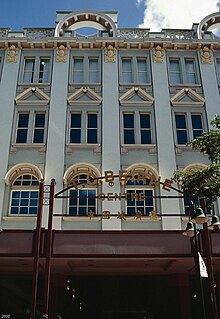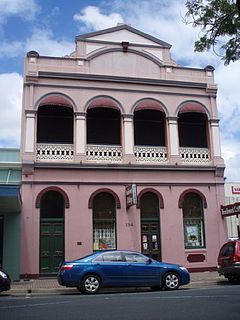The Woolstore Precinct is a residential area in the suburb of Teneriffe in Brisbane, Australia. A former industrial and commercial area, it has undergone urban renewal with preservation and re-purposing of many buildings from the early 20th century. This renewal has been guided by neighbourhood plans formulated by Brisbane City Council, with advice from the Queensland Heritage Council.

Queensland Primary Producers No 4 Woolstore is a heritage-listed warehouse at 16 Skyring Terrace, Teneriffe, City of Brisbane, Queensland, Australia. It was built from 1930s to 1940s. It is also known as Commercial House. It was added to the Queensland Heritage Register on 21 October 1992.

Goldsbrough Mort Woolstore is a heritage-listed warehouse at 88 Macquarie Street, Teneriffe, City of Brisbane, Queensland, Australia. It was built c. 1933 by Stuart Brothers (Sydney). It was added to the Queensland Heritage Register on 21 October 1992.

Australian Estates No.1 Store is a heritage-listed former warehouse and now apartments at 50 Macquarie Street, Teneriffe, Brisbane, Queensland, Australia. It was designed by Montague Stanley and built from c. 1926 to 1927 by Stuart Brothers (Sydney). It is now known as the Saratoga Woolstore Apartments. It was added to the Queensland Heritage Register on 21 October 1992.

Australian Estates No. 2 Store is a heritage-listed former warehouse and now apartments at 24 Macquarie Street, Teneriffe, City of Brisbane, Queensland, Australia. It was built c. 1957. It was added to the Queensland Heritage Register on 21 October 1992.

Elder Smith Woolstore is a heritage-listed warehouse at 64 Macquarie Street, Teneriffe, City of Brisbane, Queensland, Australia. It was designed by Montague Stanley and built in 1926 by Stuart Brothers (Sydney). It was added to the Queensland Heritage Register on 21 October 1992.

Mactaggarts Woolstore is a heritage-listed wool warehouse at 53 Vernon Terrace, Teneriffe, City of Brisbane, Queensland, Australia. It was built in 1926 by Stuart Brothers (Sydney). It was added to the Queensland Heritage Register on 21 October 1992.

Australian Mercantile Land & Finance Woolstores is a heritage-listed former warehouse now apartments at 34 Vernon Terrace, Teneriffe, City of Brisbane, Queensland, Australia. Designed by Robin Dods of Hall and Dods, the first woolstore was built in 1912 by Walls & Juster and the second was built in 1922. They were added to the Queensland Heritage Register on 21 October 1992.

Teneriffe Village is a heritage-listed warehouse at 110 Macquarie Street, Teneriffe, City of Brisbane, Queensland, Australia. It was built from 1955 to 1957. It is also known as Dalgety & Co. Ltd No 3 Woolstore, Queensland Primary Producers, No 8 Woolstore, and Paddys Market. It was added to the Queensland Heritage Register on 21 October 1992.

Craigston is a heritage-listed apartment block at 217 Wickham Terrace, Spring Hill, City of Brisbane, Queensland, Australia. It was designed by Atkinson & Conrad and built in 1927. It was added to the Queensland Heritage Register on 21 October 1992.

Lister House is a heritage-listed office building at 79 Wickham Terrace, Spring Hill, City of Brisbane, Queensland, Australia. It is also known as the Brisbane Clinic. It was designed by Raymond C Nowland and built from 1930 to 1948 by J I Green & Son. It was added to the Queensland Heritage Register on 21 October 1992.

Ballow Chambers is a heritage-listed office building at 121 Wickham Terrace, Spring Hill, City of Brisbane, Queensland, Australia. It was designed by Lange Leopold Powell and built from 1924 to 1926 by John Hutchinson. It was added to the Queensland Heritage Register on 21 October 1992.

Wickham House is a heritage-listed office building at 155-157 Wickham Terrace, Spring Hill, City of Brisbane, Queensland, Australia. It was designed by Francis Richard Hall and built from 1923 to 1924 by F J Corbett. It was added to the Queensland Heritage Register on 23 June 2000.

The TC Beirne Department Store is a heritage-listed former department store at 28 Duncan Street, Fortitude Valley, City of Brisbane, Queensland, Australia. It was designed by Robin Dods and built in 1902. Further extensions were made through to 1938 to the designs of Dods and Hennessey & Hennessey. It was added to the Queensland Heritage Register on 12 December 2003.

Telecommunications House is a heritage-listed former clubhouse and now office building at 283 Elizabeth Street, Brisbane City, City of Brisbane, Queensland, Australia. It is also known as Corbett Chambers. It was designed by Claude William Chambers and built from 1906 to 1909 and was further extended c. 1914. It was added to the Queensland Heritage Register on 5 April 2004.

Watson Brothers Building is a heritage-listed warehouse at 129 Margaret Street, Brisbane City, City of Brisbane, Queensland, Australia. It was designed by Richard Gailey and built from 1887 to 1918. It was added to the Queensland Heritage Register on 23 April 1999.

The Royal Bank of Queensland Building is a heritage-listed former bank building at 194 Quay Street, Rockhampton, Rockhampton Region, Queensland, Australia. It was built in 1888. It is also known as Diamonds & Pearls, Rivers Restaurant, and Winchcombe Carson. It was added to the Queensland Heritage Register on 21 October 1992.

The Dalgety Offices is a heritage-listed office building at 1-13 Sturt Street, Townsville CBD, City of Townsville, Queensland, Australia. It was designed by Walter Hunt and built from 1923 to 1925 by William Hornby Turner. It is also known as Sunskill House. It was added to the Queensland Heritage Register on 26 August 2005.
Woolstore or Woolstores may refer to:

























